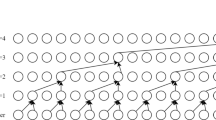Abstract
The rapid development of speech communication technology has made it possible for low bit-rate speech to become appropriate steganographic cover media. To incorporate data hiding into the low bit-rate speech codec, a novel steganography algorithm is proposed in this paper. By analyzing the encoding rule of fixed codebook vector, the way of transposing encoding locations of adjacent pulses is found to be suitable for data embedding with good imperceptibility. Based on encoding location transposition of adjacent pulses, the relationship between adjacent pulse locations is used to embed secret data while the fixed codebook search is being conducted during the encoding process of G.729 codec, which can maintain synchronization between data embedding and speech encoding. The experimental results demonstrate that the proposed steganography algorithm performs well in imperceptibility with a hiding capacity of 550 bits/s. Furthermore, the real-time and anti-detection performances are also satisfactory.










Similar content being viewed by others
References
An4 database (1991) http://www.speech.cs.cmu.edu/databases/an4/
Huang Y, Liu C, Tang S, Bai S (2012) Steganography integration into a low-bit rate speech codec. Inf Forensics Secur 7:1865–1875, IEEE Transactions on
ITU-T, Recommendation P (2001) 862-perceptual evaluation of speech quality (PESQ): an objective method for end-to-end speech quality assessment of narrow-band telephone networks and speech codecs. International telecommunication union-telecommunication standardization sector (ITU-T)
ITU-T, Recommendation G107 (2002) The E-Model, a computational model for use in transmission planning
Liu Q, Sung AH, Qiao M (2009) Temporal derivative-based spectrum and mel-cepstrum audio steganalysis. Inf Forensics Secur 4:359–368
Liu J, Zhou K, Tian H (2012) Least-significant-digit steganography in low bitrate speech. In: Proceedings of IEEE international conference on communications:1133–1137
Mazurczyk W (2013) VoIP steganography and its detection-a survey. ACM Comput Surv (CSUR) 46(2):20
Su Y, Huang Y, Li X (2006) Steganography-oriented Noisy Resistance Model of G.729a. In: Proceedings of IMACS multiconference:11–15
Tang S, Chen Q, Zhang W et al (2015) Universal steganography model for low bit-rate speech codec. Secur Commun Netw. doi:10.1002/sec.1183
Tian H, Jiang H, Zhou K, Feng D (2011) Adaptive partial-matching steganography for voice over IP using triple M sequences. Comput Commun 34:2236–2247
Tian H, Liu J, Li S (2014) Improving security of quantization-index-modulation steganography in low bit-rate speech streams. Multimedia Systems 20:143–154
Tian H, Zhou K, Jiang H, Huang Y, Liu J, Feng D (2009) An M-sequence based steganography model for voice over IP. In: Proceedings of the 44th IEEE international conference on communications, Dresden, Germany:1–5
Tian H, Zhou K, Feng D (2010) Dynamic matrix encoding strategy for voice-over-IP steganography. J Cent S Univ Technol 17:1285–1292
Tian H, Zhou K, Lu J (2012) A VoIP-based covert communication scheme using compounded pseudorandom sequence. Int J Adv Comput Technol 4(1):223–230
Wei Z, Zhao B, Liu B et al (2014) A novel steganography approach for voice over IP. J Ambient Intell Humaniz Comput 5(4):601–610
Wu Z, Cao H, Li D (2015) An M-sequence based steganography model for voice over IP. Chin J Electron 24(1):157–165
Yan S, Tang G, Sun Y, Gao X, Shen L (2014) A triple-layer steganography scheme for low bit-rate speech streams. Multimed Tools Appl 1–20. doi:10.1007/s11042-014-2265-y
Author information
Authors and Affiliations
Corresponding author
Rights and permissions
About this article
Cite this article
Yan, S., Tang, G. & Chen, Y. Incorporating data hiding into G.729 speech codec. Multimed Tools Appl 75, 11493–11512 (2016). https://doi.org/10.1007/s11042-015-2865-1
Received:
Revised:
Accepted:
Published:
Issue Date:
DOI: https://doi.org/10.1007/s11042-015-2865-1




